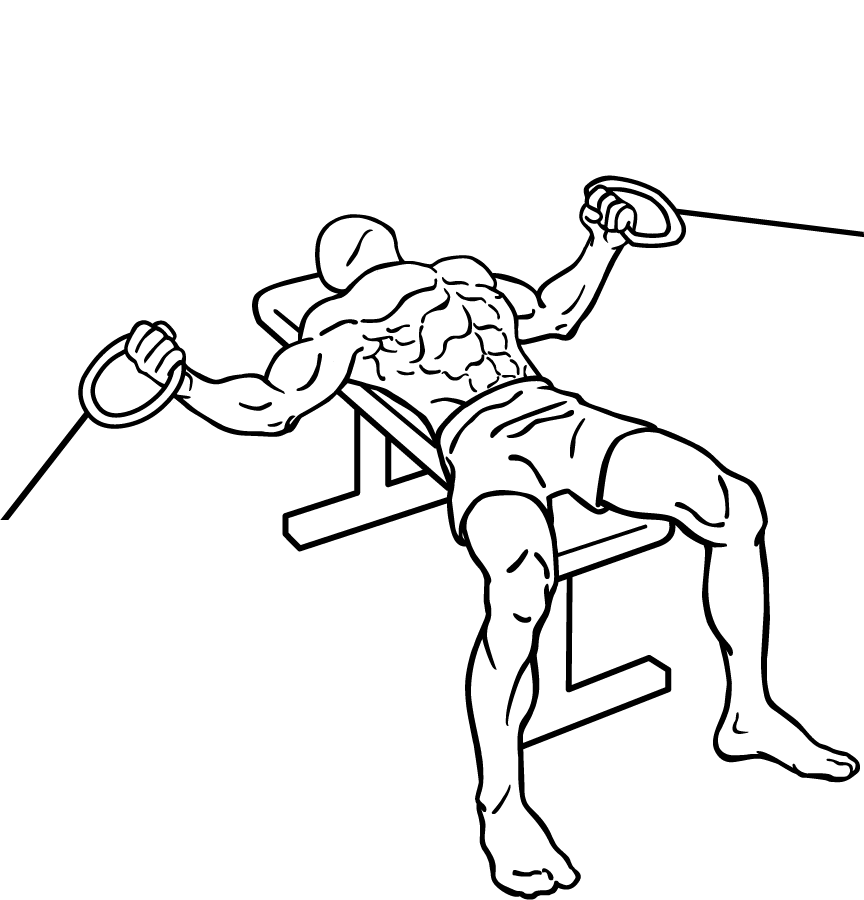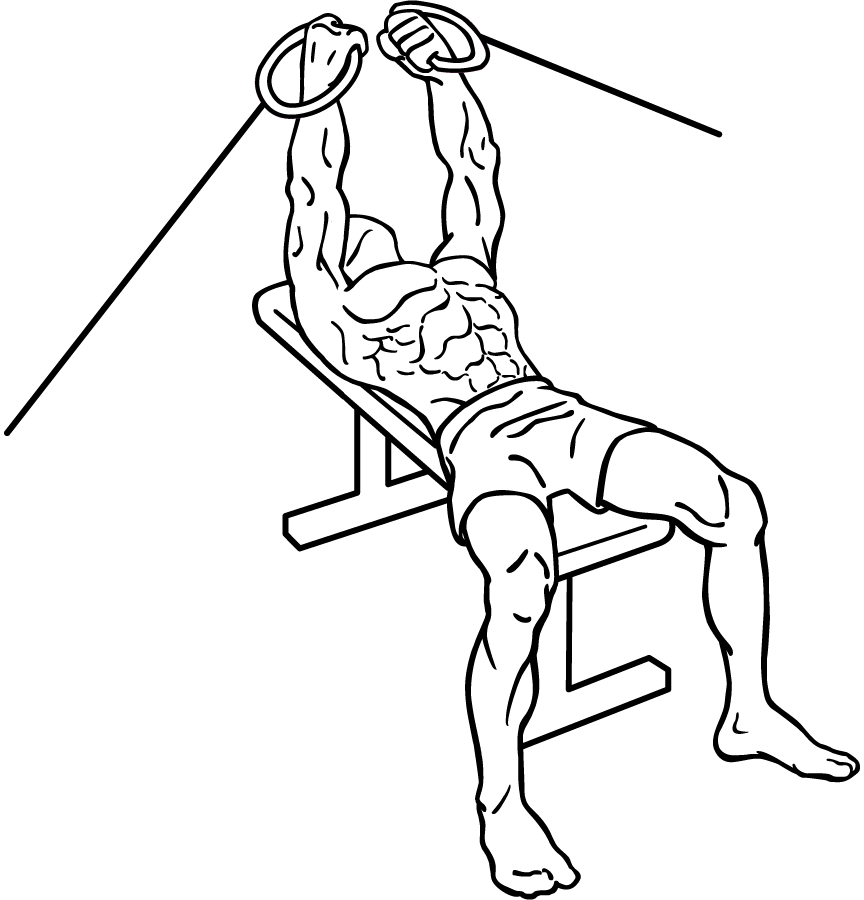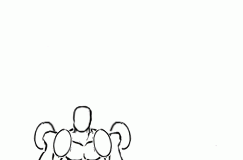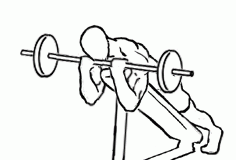Last Updated on September 30, 2014
The Flat Bench Cable Flys is an excellent exercise for targeting the chest muscles while also engaging the shoulders. Unlike traditional dumbbell flys, using cables allows for constant tension throughout the entire range of motion, making this an ideal movement for anyone looking to improve chest definition and strength. The cable fly is particularly effective for isolating the pectoral muscles, and the flat bench position emphasizes the middle part of the chest. Additionally, this exercise provides a great stretch at the bottom of the movement, which can contribute to improved flexibility and muscle development over time.
In this guide, we’ll delve into the benefits of the Flat Bench Cable Fly, how to perform it correctly, common mistakes to avoid, and variations to help you get the most out of your chest workout. Whether you’re looking to enhance your upper-body strength or improve your overall physique, this exercise should be a key component of your training routine.
Why Do Flat Bench Cable Flys?
The Flat Bench Cable Fly offers several advantages over other chest exercises, making it a must-do for those looking to build a bigger, stronger chest. Here’s why this movement should be included in your workout routine:
- Constant Tension on the Muscles: One of the primary benefits of using cables over free weights is that they provide continuous tension on the muscles throughout the entire range of motion. This makes the exercise more effective for muscle hypertrophy (growth), as the chest is under strain from the beginning to the end of the movement.
- Better Muscle Isolation: Unlike compound exercises like the bench press, which involve multiple muscle groups, the Flat Bench Cable Fly is an isolation exercise. It focuses primarily on the pectoral muscles, allowing you to concentrate on working your chest without involving other muscles like the triceps or shoulders as much.
- Improved Range of Motion: The cable setup allows for a greater range of motion compared to dumbbells. You can bring your hands closer together and stretch further at the bottom, which maximizes the effectiveness of the movement and helps improve flexibility in the chest and shoulders.
- Reduced Stress on the Joints: Some people find that traditional dumbbell flys place too much strain on their shoulders or elbows. The cables allow for a smoother, more controlled movement, which can reduce the risk of injury and make the exercise more comfortable for those with joint issues.
- Chest Symmetry and Balance: Because the cables work independently of each other, they help correct muscle imbalances. This is especially important for ensuring that both sides of your chest are equally developed, which can improve aesthetics and reduce the risk of injury from uneven muscle growth.
Muscles Worked in Flat Bench Cable Flys
The Flat Bench Cable Fly primarily targets the pectoralis major, the large muscle that makes up most of your chest. However, it also engages several other muscles to stabilize and support the movement:
- Pectoralis Major (Chest): The main focus of this exercise is the pectoralis major, which is responsible for bringing the arms together in front of the body. The flat bench position emphasizes the middle portion of the chest, helping to build overall chest size and strength.
- Anterior Deltoids (Front Shoulders): The anterior deltoids assist in the movement by helping to bring the arms forward. Although the chest does most of the work, the shoulders are still engaged throughout the exercise, making this an effective movement for shoulder strengthening as well.
- Biceps: The biceps are involved in stabilizing the arms as you bring the cables together. While they aren’t the primary muscles being worked, they still contribute to the overall movement.
- Core and Stabilizer Muscles: To maintain balance on the bench, your core and other stabilizer muscles, including the muscles of your lower back, are activated to keep your body stable and in the correct position.
Step-by-Step Guide to Performing Flat Bench Cable Flys
Equipment Needed:
- Flat Bench: This provides support for your back and allows you to perform the exercise while lying down.
- Cable Machine with Adjustable Pulleys: Ensure the pulleys are positioned at a height that allows you to perform the fly motion effectively.
Starting Position:
- Set Up the Bench Between Two Cable Towers: Position a flat bench between two cable towers, ensuring that the pulleys are set at a low to medium height. Adjust the height so that when you lie on the bench, your arms can extend comfortably without straining your shoulders.
- Lie Flat on the Bench: Lie down with your back flat on the bench, feet firmly planted on the ground. Ensure that your back and hips remain in contact with the bench throughout the movement to avoid unnecessary strain on your lower back.
- Grasp the Handles: Reach out and grasp a pulley handle in each hand with your palms facing upward. Your arms should be extended but with a slight bend in the elbows to protect your joints. This is your starting position.
The Movement:
- Engage Your Core and Chest: Before starting the movement, engage your core to stabilize your body and focus on using your chest muscles to move the cables.
- Pull the Cables Together: Slowly bring your hands together in a wide arc, mimicking the motion of hugging a large tree. Keep a slight bend in your elbows and focus on squeezing your chest as you pull the cables toward each other. The cables should meet at the center of your chest, just above your sternum.
- Squeeze and Hold: Once the cables meet in the middle, pause for a moment and squeeze your chest muscles. This is where you’ll feel the maximum contraction, so take a brief moment to focus on the tension in your pectorals.
- Lower with Control: Slowly reverse the movement, allowing the cables to return to the starting position. As you lower your hands, keep the motion controlled and avoid letting the cables snap back. Your arms should extend fully at the bottom without locking your elbows.
- Repeat: Perform 8–12 repetitions, depending on your fitness level and goals. Complete 3–4 sets to maximize the effectiveness of the exercise.
Tips for Proper Form and Technique
- Maintain a Slight Bend in Your Elbows: Keeping a slight bend in your elbows throughout the exercise is important for protecting your joints and ensuring the focus remains on your chest. Fully extended arms can place unnecessary strain on the elbows and shoulders.
- Keep Your Back and Hips Flat on the Bench: One common mistake is allowing your back to arch or your hips to lift off the bench as you bring the cables together. This can reduce the effectiveness of the exercise and increase the risk of injury. Keep your back, hips, and feet firmly in contact with the bench and floor to maintain proper form.
- Control the Movement: Avoid using momentum to bring the cables together. The movement should be slow and controlled, with a focus on using your chest muscles to perform the exercise. Lowering the cables with control is just as important as lifting them, so don’t rush through the movement.
- Focus on the Chest Contraction: The key to maximizing the benefits of the Flat Bench Cable Fly is to focus on the contraction in your chest muscles. Visualize your chest doing the work, and squeeze your pecs together at the top of the movement to fully engage the muscle.
- Avoid Going Too Heavy: While it can be tempting to load up the weight, it’s more important to prioritize form over heavy resistance. Start with a moderate weight that allows you to perform the exercise with perfect technique. You can gradually increase the weight as your strength improves.
Common Mistakes to Avoid
- Arching Your Back: Lifting your back off the bench is a common mistake that reduces the effectiveness of the exercise and increases the risk of lower back strain. Always keep your back and hips firmly pressed against the bench to maintain proper alignment.
- Locking Your Elbows: Fully extending your arms at the top or bottom of the movement can place too much strain on your elbows. Always keep a slight bend in your elbows throughout the exercise to protect your joints.
- Using Too Much Weight: It’s better to start with lighter weights and focus on proper form rather than using too much weight, which can compromise your technique and lead to injury.
- Rushing Through the Movement: Performing the exercise too quickly reduces muscle engagement and makes the exercise less effective. Always use slow, controlled movements to ensure you’re working the chest muscles properly.
Variations of Flat Bench Cable Flys
To keep your workouts challenging and interesting, try incorporating these variations of the Flat Bench Cable Fly:
- Incline Cable Flys: Perform the same movement on an incline bench to target the upper portion of the chest. This variation shifts the emphasis from the middle of the chest to the upper pectoral muscles.
- Decline Cable Flys: Use a decline bench to target the lower portion of the chest. This variation is effective for building the lower pecs and improving overall chest development.
- Single-Arm Cable Fly: Perform the exercise with one arm at a time to focus on unilateral chest development. This variation helps correct muscle imbalances and increases core stabilization.
- Standing Cable Fly: Instead of lying on a bench, perform the cable fly in a standing position. This variation engages your core and lower body muscles to maintain balance, while still targeting the chest.
- Superset with Push-Ups: For an added challenge, try supersetting Flat Bench Cable Flys with push-ups. Perform a set of cable flys followed immediately by a set of push-ups to fully exhaust your chest muscles.
How to Incorporate Flat Bench Cable Flys into Your Workout Routine
The Flat Bench Cable Fly can be a versatile addition to your chest workout routine, whether you’re focusing on hypertrophy, strength, or endurance. Here are several ways to incorporate it effectively:
- Chest Day Focus: On days when you’re targeting your chest, the Flat Bench Cable Fly should be one of your key isolation exercises. Start with a compound movement like the bench press to engage the chest, triceps, and shoulders, and then follow it with 3–4 sets of Flat Bench Cable Flys to isolate and fully engage the pectoral muscles.
- Upper Body Workouts: If you’re training your entire upper body in one session, include the Flat Bench Cable Fly as one of your main chest exercises. Pair it with shoulder and back exercises such as overhead presses, rows, or lateral raises to ensure a balanced upper body workout.
- As a Finisher: After completing your heavier lifts like bench presses or dips, use Flat Bench Cable Flys as a finisher to fully fatigue your chest muscles. Perform 3–4 sets with lighter weight but higher repetitions (12–15 reps) to get a great pump and ensure that your muscles are thoroughly worked by the end of your session.
- Supersets and Circuits: Combine Flat Bench Cable Flys with other chest or shoulder exercises in supersets or circuits. For example, alternate between Flat Bench Cable Flys and incline dumbbell presses, with minimal rest between sets. This will increase the intensity of your workout and help build both strength and endurance in your chest.
- Full-Body Workouts: On full-body workout days, you can include the Flat Bench Cable Fly as one of your primary chest exercises. Pair it with lower body and core movements like squats or lunges to ensure that you’re working all the major muscle groups.
Sample Flat Bench Cable Fly Workout
Here’s a sample chest-focused workout incorporating the Flat Bench Cable Fly:
- Warm-Up: 5–10 minutes of light cardio (e.g., jogging or cycling) followed by dynamic stretching for the chest, shoulders, and arms.
- Barbell Bench Press: 4 sets of 8–10 repetitions.
- Incline Dumbbell Press: 3 sets of 10–12 repetitions.
- Flat Bench Cable Flys: 3 sets of 12 repetitions, focusing on slow, controlled movements and squeezing the chest at the top of each rep.
- Push-Ups: 3 sets to failure (as many reps as you can).
- Cool Down: Static stretching, focusing on the chest, shoulders, and arms.
This workout targets all areas of the chest and shoulders, with Flat Bench Cable Flys providing a great way to isolate the pecs after heavier compound lifts.
Benefits of Regular Flat Bench Cable Fly Training
Consistently performing Flat Bench Cable Flys will deliver a range of benefits, especially if you’re looking to improve your chest strength and size. Some key advantages include:
- Greater Chest Definition: The isolation provided by the Flat Bench Cable Fly helps build better definition in the chest muscles, making this an ideal exercise for those seeking to sculpt and shape their upper body.
- Increased Range of Motion: The cables allow for a deeper stretch at the bottom of the movement, which not only engages the muscle fibers more but also improves flexibility in the chest and shoulders over time.
- Improved Muscle Balance: Since each arm works independently, the Flat Bench Cable Fly helps correct muscle imbalances between the left and right sides of the body, contributing to more symmetrical chest development.
- Enhanced Shoulder and Chest Mobility: Regularly performing this exercise helps increase the mobility and flexibility of your shoulders and chest, reducing the risk of injury in other exercises like the bench press.
- Reduced Joint Stress: The cable system allows for smoother movements and less stress on the joints compared to traditional free weight exercises like dumbbell flys. This makes it an excellent option for individuals with joint discomfort or those recovering from injuries.
The Flat Bench Cable Fly is a must-have in any chest workout routine. It offers numerous benefits, from increased chest strength and muscle definition to improved flexibility and shoulder mobility. Whether you’re a beginner looking to build a stronger foundation or an experienced lifter aiming to refine your chest training, this exercise will help you reach your goals.
Remember, proper form is essential to getting the most out of this movement. Focus on keeping your back flat, controlling the weight, and engaging your chest muscles throughout the entire range of motion. Start with lighter weights to master the technique, and gradually increase the load as your strength improves.
Incorporating Flat Bench Cable Flys into your workouts, whether as part of a chest-focused day or a full-body routine, will bring significant improvements to your upper body strength, balance, and overall physique. So the next time you’re at the gym, set up the cables, lie down on that bench, and get ready to feel the burn as you fly your way to a stronger chest!








